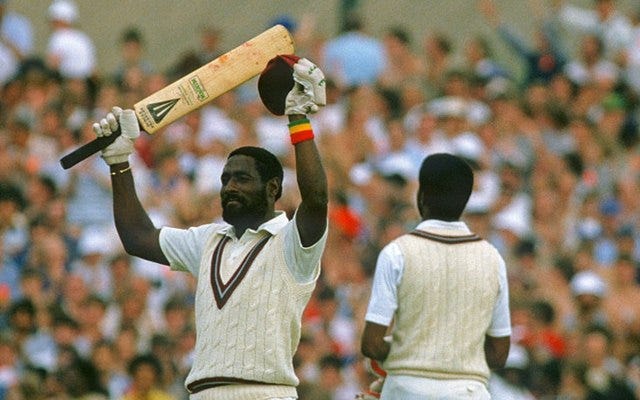In this article, for a bit of fun, I’m looking at historical West Indian players who could comprise a powerful T20 XI today. But before I continue, I need to establish some house rules.
Firstly, I will focus on players from the 1990s or earlier. These players went through their careers without having to take T20 cricket into account, so I think this will create the most interesting XI.
Secondly, let’s acknowledge that we won’t find players from the pre-T20 era with stats comparable to modern T20 players. A Test player from the 1930s isn’t going to have a strike rate of over 150 or the array of quality variations perfected by bowlers like Ravi Rampaul and DJ Bravo. Instead, I will look at their mental approach to the game and their stats in the context of their era. This will allow me to assign them specific roles in the T20 XI.
Lastly, as mentioned above, I will use specific roles to construct this team. These will mostly come from the positions that have been explicitly or vaguely noted by the current coach of the WI T20 side, Darren Sammy. The roles are as follows:
Attacking Opener
Slower Opener
Late Powerplay Hitter / Middle Order Attacker
Marlon Samuels Role / Middle Order Anchor and Innings Builder
Finisher
Pacing All-Rounder / Finisher
Left-Arm Pacer / Seamer
Powerplay and Death Over Pacer / Seamer
Powerplay and Death Over Pacer / Seamer
Leg Spinner
Off-Spinner / Slow Left-Arm Spinner
In addition to the above, at least one player will need to fill the wicket-keeper role, and someone will need to be captain. It would be a boon if at least one of the primary batters can also aid in the bowling line, but, as seen in the recent team iterations, while not ideal, it’s possible to use only five bowlers.
Okay, with the house rules in place, let’s dive into the fun part and figure out which legends of West Indies cricket would thrive in the T20 format.
11. Off-Spinner or Slow Left-Armer
Some of you might be wondering why I combined these two bowling types into a single spot. I think, in the modern game, an off-spinner has a stronger claim to a T20 spot than a slow left-armer (think of Sri Lanka’s Theekshana or India’s Ravi Ashwin). But right now, the West Indies doesn't just have an abundance of SLO bowlers, in Akeal Hosein and Gudakesh Motie, they have the two highest-ranked SLOers in T20I. I wanted to take both of these aspects into account when constructing the team.
For this spot, however, I went with an off-spinner. Lance Gibbs is my first conscript, and he probably needs no introduction. He is tall, attacking, and one of the most economical spinners in history. His control and flight would be a nightmare on slow T20 pitches. With over 300 wickets to his name, we all know what an absolute monster he was in Tests. Plus, he’s the kind of spinner you could bowl in the powerplay knowing he’d keep it tight, just like Hosein and Badree.
10. Leg Spinner
Honestly, this one was tough. Historically, the West Indies has struggled to produce high-quality legging for the international game, especially in comparison to other countries, but having a quality leg spinner is almost a requirement for the modern T20 circuit. West Indies has tried to get by using two SLOers instead, but I won’t grant myself the same luxury, especially when Sonny Ramadhin is right there.
Now, let me get a word in before you type something like: “Wasn’t Ramadhin an off-break mystery spinner?” You’re right, of course, but Ramadhin’s dominance primarily came from his ability to confuse batters. He had the ability to bowl both off-break and leg-break, meaning it didn’t matter whether the batter was left or right-handed. In my opinion, that skill is very similar to the strength in variations that dedicated leggies use in the modern game.
Ultimately, Sonny Ramadhin’s variation and guile make him this team’s wildcard choice. Tough to pick and tough to put away, he would have been perfect for the modern T20 environment. In a way, he offers a combination of the skills of both Narine and Badree, and if that doesn’t terrify and excite you at the same time, I don't know what will.
9. Powerplay and Death Over Pacer / Seamer
To be frank, slots 9 and 8 are probably the most guessable players to anyone who knows their West Indies history. We are looking for someone who can take up the new ball and bend it to their will. This is someone who can come in at the death and scare batters away from lashing out. In short, we are looking for twin-pitch demons.
The Hitman, Sir Andy Roberts, walks into the side. Really, do I need to say more? Let’s put it this way: In the 1970s, almost half a century before T20 bowling found innovation, Roberts was whitewashing England with his variations. Not only did he have unique deliveries like the Lull and Surprise, but he also varied his run-ups and release points with the goal of confusing and unsettling batsmen. In modern T20, he would run circles around any tail-end vooper. And he has the consistency and aura to knock down any opening pair.
8. Powerplay and Death Over Pacer / Seamer
Of all the West Indian pacers who emerged between the 1970s and 1990s, perhaps no one deserves to partner with Sir Andy Roberts more than the original Double M, Malcolm Marshall. There’s so much that can be and has been said about this legendary player, so I don’t need to be his advocate here. His ability to swing the ball would make him unplayable in the powerplay, and with his deadly accuracy, I would not expect anything short of two or three death overs of nailed yorkers.
7. Left-Arm Pacer / Seamer
Surprisingly, this role was more difficult to fill than the leggie. I even considered scrapping it and using another right-armer instead. The sad truth is the West Indies has always struggled to produce left-arm seamers. One of the more recent options would have been Pedro Collins, but he violated the ruleset by playing twenty-nine T20 games. To put the dryness of this well into perspective, when I asked AI to name five West Indian left-arm pacers, one of the names it gave me was Raymon Reifer. No disrespect to Reifer, but come on now, we can do better than that.
Eventually, it came down to two names: Sir Frank Worrell and Bernard Julien. As much as I love Sir Worrel and what he meant to the West Indies, I feel like selecting him for this role would be an injustice and a waste of his talents. For that reason (and my Trini bias), I had to go with my countryman, Bernard Julien. Do not get it twisted, though. He might look like a long-lost Mungo Jerry band member, but Julien wouldn’t be a slacker.
What Julien lacks in name recognition, he more than makes up for in the depth of knowledge and variations he developed during his tenure. Julien was a skilful swing bowler, capable of moving the ball both ways and varying his pace. This makes him perfect for T20 cricket, where changes of pace and subtle movement are gold. His lower cutters, subtle variations, and left-arm angle would be an ideal pair to a middle-over spinner, in addition to helping out at the death.
Julien’s selection also offers a lot of variability to the order. He’s more than capable of floating up the order and taking extra responsibility if a crash happens.
Buttressing all of that is his intelligence and cunning. He may not be the fastest, but he doesn’t need to be, we have Marshall and Roberts for that. Julien thrives when he’s asked to think his way through spells, and he does so in a way that most bowlers can’t. In that context, Bernard Julien is a no-brainer pick for this team.
6. Pacing All-Rounder / Finisher
This is a critical role in any T20 side, someone who can bowl at serious pace and finish innings with the bat. This person’s name needs to induce fear in any opposition team, both with bat and ball. They need to be so prolific that entire opposition strategies are formed around them.
It feels impossible not to pick Sir Garfield Sobers here. You might accuse me of using a cheat code, but Sobers could genuinely bowl left-arm pace, orthodox spin, and wrist spin. And with the bat, he was as good as anyone who’s ever played the game. I mean, for heaven’s sake, the man hit six sixes in an over. What more do you want? He fits this role, any role, and every role.
5. Finisher
Now, this is where things get fun. This guy has one job: Come to the crease with five overs remaining and send every ball into the car park. Sir Gordon Greenidge is our star man. This pick will surprise a lot of people because he is primarily known for being an opening batsman, but had he been born in the 1990s or 2000s, I think Sir Greenidge would have adjusted his style of play to suit this role nicely. His natural power and range of shots just scream modern finisher, and he had the acumen and flair to perform the destructive Andre Russell-type batting this position warrants.
I think his bio on Cricinfo says it best:
“Attacking was in his genes. Never in the game has there been a more withering and dismissive square-cut, nor a more willing and able hooker and puller, but he drove mightily too on both sides of the wicket.”
4. Marlon Samuels Role (and Wicket-Keeper)
Arguably, the ‘Marlon Samuels role’ shouldn’t exist in the modern era of T20 teams, but unfortunately, the West Indies is not privileged enough to exist without it.
This role has always been that of the stylish but steady head — the batter who can slow down or accelerate depending on the match scenario. At the same time, the team is currently missing a solid wicket-keeper. Few batters in West Indies history fit both roles better than the batting stalwart and elite glovesman Jeffrey Dujon.
His ability to steadily accumulate runs often goes unsung, but he is someone who just knew how to build an innings. In addition to his solid batting reputation, his glove work was simply the best the region has ever seen in any format. He made the template that later T20 greats like Dinesh Ramdin emulated and adapted to suit the modern game.
He would also give this lineup a left-handed option and provide a calm presence to counterbalance the power-hitters.
3. Late Powerplay Hitter / Middle Order Attacker (and Captain)
This role is often where modern T20 sides inject raw power — a guy who comes in around the fifth to seventh over and keeps the pressure on. In the modern set-up, this role is typically reserved for Nicholas Pooran, and we see it repeated in other teams who deploy the likes of Jos Butler, Sk Yadav, and Aiden Markram.
For this spot, I have selected none other than Clive Lloyd. I know the Guyanese fans out there will be cheering this pick. Big, burly, and a natural six-hitter in his time, Lloyd was never afraid to take the aerial route. In a T20 world, you could see him coming in and just clearing ropes from ball one. He’s our ideal bridge between the openers and the back-end fireworks.
On the other hand, his tactical prowess and ability to dig into the crease when needed means he’d also be a perfect fit if an opener were to lose their wicket early. If you would allow me the pun, Lloyd fits this role like a glove.
Due to his versatile abilities as both a batter and a tactician, I also have Lloyd as my captain. His leadership would allow both the bowling attack and the batters to bring out their aggression and knock down whoever was in their way, Alzarri-style.
2. Slower Opener
This role is a bit more nuanced as you need someone capable of absorbing pressure, batting deep if needed, but also keeping the scoreboard ticking. Desmond Haynes comes to mind, and he would be a fine pick for the role, but I want some wristy brilliance and a little more flair, so Lawrence ‘Yagga’ Rowe is the man I would trust with this responsibility.
Yagga’s cool-under-pressure mentality makes him the perfect choice to anchor the start of an innings. He would allow others to bat around him while he steadily ticked the score forward with some of the most elegant drives you could ever hope to witness in cricket.
With so much batting prowess already in the side, from Lloyd to Sobers, the stability and class of Rowe is an affordable cost. When in form, he brings flair, pure aesthetic joy, and unpredictability, making him difficult to prepare for if you’re on the opposing team.
1. Attacking Opener
For this role, we’re looking for a player with natural flamboyance — someone who didn’t just accumulate but dominate. In this slot, Sir Viv Richards feels like the easiest call of the whole exercise. Sir Viv, with his swagger, power, and ability to intimidate bowlers, is the prototype of a modern T20 aggressor; the proto Evin Lewis or Chris Gayle.
Imagine being a fast bowler, thinking you're the baddest around, probably wearing two gold chains, then out strides Sir Viv, shirt buttons undone and not even wearing a helmet. His presence undoes whatever mental faculties exist in the bowler’s mind. You just know if T20 existed in his time, he’d be smashing 80 off 40 like it was routine.
The Lineup
Our historical West Indies T20 XI is as follows:
Sir Viv Richards
Lawrence Rowe
Clive Lloyd (C)
Jeffrey Dujon (WK)
Sir Gordon Greenidge
Sir Garry Sobers
Bernard Julien
Malcolm Marshall
Sir Andy Roberts
Sonny Ramadhin
Lance Gibbs
Putting this team together was never about building the perfect T20 side. Instead, it was about having some fun imagining how the legends of West Indies cricket might slot into a format they never played, but whose spirit they helped create. T20 cricket demands power, flair, intelligence, and ice-cold nerves — all qualities that have long been part of West Indies DNA.
Whether it’s the stride of Viv Richards, the cool elegance of Lawrence Rowe, the raw pace of Roberts and Marshall, or the crafty left-arm swing of Bernard Julien, you can easily see how these players could have thrived in the T20 era — even going so far as to redefine the format in their own way.
And sure, their stats might not match up to today’s standards, but the mentality was always there. It’s a fun reminder that before T20 cricket had a name, the West Indies were already playing a fearless and audacious brand of cricket that made the world stop and watch.
Now, if only we had a time machine and a CPL contract ready for these guys.
Thank you to Steph Jaggassar for her article you can find her on Substack - here
The Caribbean Cricket Podcast is on Facebook and of course you can also find us on X and Instagram and all other social media platforms.
If you'd like to support the Caribbean Cricket Podcast you can become a patron for as little as £1/$1 a month - Here
You can buy the brand new Caribbean Cricket Podcast beanies now - please get in touch if you are interested in getting one.













Thank you for imparting such wisdom and history upon us all.
Great article as usual Steph!